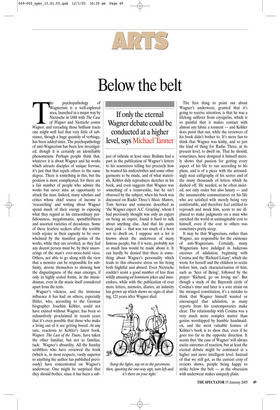Below the belt
The psychopathology of Wagnerism is a well-explored area, launched in a major way by Nietzsche in 1888 with The Case of Wagner and Nietzsche contra Wagner, and rereading those brilliant tracts one might well feel that very little of substance, though a huge quantity of verbiage, has been added since. The psychopathology of anti-Wagnerism has been less investigated, though it is certainly an identifiable phenomenon. Perhaps people think that, whatever it is about Wagner and his works which attracts disciples of unique fervour, it’s just that that repels others to the same degree. There is something in this, but the position is more complicated, for there are a fair number of people who admire the works but never miss an opportunity to attack the man. Indeed, many scholars and critics whose chief source of income is ‘researching’ and writing about Wagner spend much of their energy in exposing what they regard as his extraordinary perfidiousness, megalomania, spendthriftness and assorted varieties of decadence. Some of these fearless seekers after the terrible truth rejoice in their capacity to be overwhelmed by the manifest genius of the works, while they are revolted, as they feel any decent person must be, by their uncoverings of the man’s ever-more-lurid vices. Others, not able to go along with the view that a monster can be responsible for sublimity, devote themselves to showing how the disgustingness of the man emerges, if only in highly coded forms, in the musicdramas, even in the music itself considered apart from the texts.
Wagner’s vileness, and the immense influence it has had on others, especially Hitler, who, according to the German biographer Joachim Köhler, could not have existed without Wagner, has been so exhaustively proclaimed in recent years that it’s even possible that those who make a living out of it are getting bored. At any rate, reactions to Köhler’s latest book, Wagner: The Last of the Titans, have taken the other familiar, but not so familiar, tack: Wagner’s absurdity. All the Sunday scribblers who have reviewed the book (which is, in most respects, vastly superior to anything the author has published previously) have concentrated on Wagner’s underwear. One might be surprised that they should bother, since it has been a sub ject of ridicule at least since Brahms had a part in the publication of Wagner’s letters to his seamstress telling her precisely how he wanted his underclothes and some other garments to be made, and of what materials. Köhler duly reproduces sketches in his book, and even suggests that Wagner was something of a transvestite, but he isn’t obsessed by the subject; when his book was discussed on Radio Three’s Music Matters, Tom Service and someone described as ‘the Wagner expert A.C. Grayling’, whom I had previously thought was only an expert on being an expert, found it hard to talk about anything else. And that his pants were pink — that was too much of a hoot not to dwell on. I suppose not a lot is known about the underwear of many famous people, but if it were, probably not so much fuss would be made about it. It can hardly be denied that there is something about Wagner’s personality which leads to this obsessive stress on his being both frightful and absurd. Even Nietzsche couldn’t resist a good number of less than wildly amusing ad hominem jokes and innuendoes, while with the publication of ever more letters, memoirs, diaries, an industry has grown up which shows no signs of abating, 121 years after Wagner died. The first thing to point out about Wagner’s underwear, granted that it’s going to receive attention, is that he was a lifelong sufferer from erysipelas, which is so painful that it makes contact with almost any fabric a torment — and Köhler does point that out, while the reviewers of his book didn’t bother to. It’s more fun to think that Wagner was kinky, and so just the kind of thing for Radio Three, at its present level, to dwell on. That he should, sometimes, have designed it himself merely shows that passion for getting every aspect of his life to run according to his plans, and is of a piece with the astoundingly neat calligraphy of his scores and of the many thousands of letters which he dashed off. He needed, as he often insisted, not only order but also luxury — and the innumerable commentators on his life who are satisfied with merely being very comfortable, and therefore feel entitled to reproach and mock him, seem to me illplaced to make judgments on a man who enriched the world at unimaginable cost to himself, even if the cost to others was sometimes pretty steep.
It may be that Wagnerians, rather than Wagner, are responsible for the existence of anti-Wagnerians. Certainly, many Wagnerians have indulged in ludicrous excesses of adulation, beginning with Cosima and the ‘Richard Litany’, which she wrote for herself and the children to recite before him, each characterisation of him, such as ‘Seer of Being’, followed by the prayer ‘Richard, go on loving me’. But though a study of the Bayreuth circle of Cosima’s time and later is a sore strain on the strongest constitution, it’s a mistake to think that Wagner himself wanted or encouraged that adulation, as many reports from his contemporaries make clear. The relationship with Cosima was a very much more complex matter than genius worshipped by humble handmaiden, and the most valuable feature of Köhler’s book is to show that, even if he goes too far in the opposite direction. It seems that ‘the case of Wagner’ will always excite extremes of reaction, but at least the eternal debate might be continued at a higher and more intelligent level. Instead of that we still get, as the current crop of reviews shows, people being happy to strike below the belt — as the obsession with underwear makes uniquely plain.





















































 Previous page
Previous page